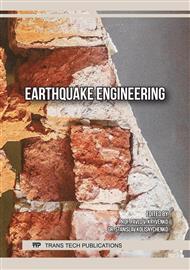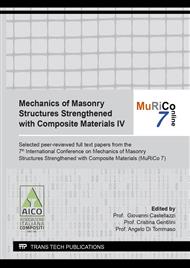[1]
N. Gattesco, A. Dudine, Effectiveness of masonry strengthening technique made with a GFRP-mesh-reinforced mortar coating, Proc. 8th Int. Masonry Conference, 4-7 July 2010, Dresden, Germany.
DOI: 10.1007/s10518-014-9684-z
Google Scholar
[2]
N. Gattesco, A. Dudine, Il rinforzo di murature esistenti con intonaco e rete in GFRP, Structural, 164 (2010) 50-61, (in Italian).
Google Scholar
[3]
N. Gattesco, A. Dudine, A GFRP mesh strengthening technique applied to ancient masonry walls, Proc. 5th International Conference on Advanced Composites in Construction 2011 - ACIC 2011, 6-8 Sept. 2011, Coventry, U.K.
Google Scholar
[4]
M. Ashraf, A. Khan, A. Naseer, Q. Ali, B. Alam, Seismic behavior of unreinforced and confined brick masonry walls before and after ferrocement overlay retrofitting. International Journal of Architectural Heritage 6 (2012) 665–688.
DOI: 10.1080/15583058.2011.599916
Google Scholar
[5]
M. Maalej, V.W.J. Lin, M.P. Nguyen, S.T. Quek, Engineered cementitious composites for effective strengthening of unreinforced masonry walls. Engineering Structures, 32 (2010) 2432-2439.
DOI: 10.1016/j.engstruct.2010.04.017
Google Scholar
[6]
P. Rocchi, A. Ambrosi, F. Braga. Atlante del consolidamento degli edifici storici. Proctor, 2008, (in Italian).
Google Scholar
[7]
A. Giuffrè, A. Sicurezza e consevazione dei centri storici: il caso Ortigia: codice di pratica per gli interventi antisismici nel centro storico. Laterza, 2000, (in Italian).
DOI: 10.4995/thesis/10251/192110
Google Scholar
[8]
ICOMOS, International Scientific Committee for Analysis and Restoration of Structures of Architectural Heritage. Recommendations for the analysis, conservation and structural restoration of architectural heritage, Guidelines of ICOMOS 14th General Assembly, Victoria Falls, US (2003).
DOI: 10.1080/13556207.2007.10785001
Google Scholar
[9]
A. Borri, G. Castori, M. Corradi, R. Sisti, Tecniche innovative di rinforzo di murature storiche. Proc. 15th Conference ANIDIS L'Ingegneria Sismica in Italia, 30 June – 4 July 2013, Padova, Italy (in Italian).
Google Scholar
[10]
E. Zanello, Rinforzo strutturale e conservazione: esempio applicativo su edifici storici in tufo, Recupero e Conservazione Magazine, 7-8 (2017) 72-82 (in Italian).
Google Scholar
[11]
L. Righetti, V. Edmondson, M. Corradi, A. Borri, A. Fibreglass grids as sustainable reinforcement of historic masonry, Materials, 9 (2016) 603.
DOI: 10.3390/ma9070603
Google Scholar
[12]
A. Borri, G. Castori, M. Corradi, A. De Maria, A method for the analysis and classification of historic masonry. Bulletin of Earthquake Engineering 13 (2015) 2647จC2665.
DOI: 10.1007/s10518-015-9731-4
Google Scholar
[13]
A. Borri, M. Corradi, A. De Maria, R. Sisti, Calibration of a visual method for the analysis of the mechanical properties of historic masonry, Procedia Structural Integrity 11 (2018) 418-427.
DOI: 10.1016/j.prostr.2018.11.054
Google Scholar
[14]
ASTM E519 / E519M Standard Test Method for Diagonal Tension (Shear) in Masonry Assemblages, (2010).
Google Scholar
[15]
M. Corradi, A. Borri, G. Castori, R. Sisti, Shear strengthening of wall panels through jacketing with cement mortar reinforced by GFRP grids, Composites Part B: Engineering, 64 (2014) 33-42.
DOI: 10.1016/j.compositesb.2014.03.022
Google Scholar
[16]
RILEM LUMB6-Diagonal tensile strength tests of small wall specimens. Tech Rep, RILEM, (1994).
DOI: 10.1201/9781482271362-309
Google Scholar
[17]
ANSYS, Engineering Simulation Software, Fluent 14.0 user's guide. ANSYS FLUENT Inc, (2011).
Google Scholar
[18]
G. Castori, A. Borri, M. Corradi, FEM analysis of masonry walls reinforced with traditional strengthening techniques. 10th International Masonry Conference, 2018. Milan, Italy.
Google Scholar
[19]
Italian Building Code, 2018. Aggiornamento delle Norme tecniche per le costruzioni (No. 8). Act 17 Jan. 2018, Gazzetta Ufficiale No. 42, (in Italian).
Google Scholar
[20]
Italian Building Code, Guidelines, Istruzioni per l'applicazione delle «Nuove Norme Tecniche per le Costruzioni» di cui al decreto ministeriale 17 gennaio 2018, (in Italian).
Google Scholar



